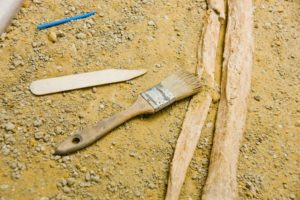
Today’s Promega Connections blog is written by guest blogger Rachel H. Oefelein, QA Manager/Senior DNA Analyst at DNA Labs International.
Shakespeare said, “The evil that men do lives after them; the good is oft interred with their bones.” This is continually true in the case of unidentified remains throughout the United States. The action of a person going missing or the events leading to an individual’s demise are frequently the memory that haunts a town or the media for years to come. However, for each such case, somewhere lies a set of skeletal remains not yet found, or just as tragic, recovered but still unidentified. The National Missing and Unidentified Persons System (NamUs) estimates approximately 40,000 sets of unidentified skeletal remains linger in morgues around the country or that have been cremated and buried as Jane and John Does.
Many crime labs do not have protocols in place for the extraction of DNA from skeletal remains or have outdated protocols for bone extraction that are not sensitive enough for poor quality bones. Bones are often recovered from harsh environments and have been exposed to extreme heat, time, acidic soil, swamp, chemicals treatment, etc. These harsh environmental conditions degrade the DNA present in the remains which further complicates the already difficult procedure of releasing the DNA in cells buried deep within the bone matrix. Another challenge is that cases often involve recovery of skeletal remains in areas with animal activity, water recoveries and scenes involving explosions or fires; these case types may require re-association of dozens if not hundreds of bones and bone fragments.
Bones: Extraction Protocol
In 2016 a modification to the existing extraction procedure at DNA Labs International was released for casework, merging the past extraction protocol with the protocol described by Dr. Odile Loreille in the 2007 Forensic Science International publication “High efficiency DNA extraction from bone by total demineralization”. The adapted procedure would include the demineralization extraction buffer outlined in the Loreille paper, capable of dissolving the bone powder in as little as 3 hours, in conjunction with the existing organic DNA extraction protocol. The collection process of preparing the bone for powdering was also enhanced. Whereas before, debris was washed or scraped from the bone and powdered via drilling, now bones are being sanded with a onetime use electronic grinding stone prior to powdering in a blender cup. This cleaning step has proven to be crucial from removing contaminants and inhibitors present on the surface of the bone.
The modified extraction of skeletal remains protocol, coupled with better bone preparation prior to powdering bone, had an immediate and profound effect on casework; first and foremost, the extraction could now be completed in less than 24 hours! Additionally, full DNA profiles were now being obtained from bones that had previously yielded no DNA. For one cold case in particular, a set of unidentified remains from a male had yielded no DNA or insufficient DNA for amplification from two previous extractions prior to. This new collection and extraction procedure yielded a nearly full profile from the femur, and the DNA profile obtained was able to be compared to the son of the missing individual in question.
With every gain in forensics, often a new problem presents itself. Many of the samples exhibited inhibition, an interference with downstream processing from components present in the sample. Analysts at DNA Labs International previously determined that the Promega PowerPlex® Fusion System often overcame inhibition without the need for the common practice of diluting the extract to dilute out inhibitors. The Promega PowerPlex® Fusion System was processed with the DNA extracts from the bones and found to be very robust. In December of 2016 the Promega PowerPlex® Fusion 6C System was released for casework at the laboratory and was found to be just as successful at amplifying and typing these challenging samples. Additionally, with both the original Promega PowerPlex® Fusion System and the new Promega PowerPlex® Fusion 6C System, the increase in loci allows for higher discrimination when comparing the DNA profile of an unknown individual to potential relatives of the deceased.
Cases that previously would have remained unsolved or taken months if not years can now be completed in as little as 72 hours from start to finish. New extraction protocols and the options with new expanded kits that can fight inhibition will be crucial in returning the ‘good within these bones’ home to their loved ones and bringing closure to all involved in laboratories throughout the country.
Related Posts
Latest posts by Promega (see all)
- Beyond Ozempic: The New Frontier of Obesity Research - April 18, 2025
- One Health and H5N1: Promega’s Commitment to Holistic Solutions - April 8, 2025
- Overcoming qPCR Inhibitors: Strategies for Reliable Quantification - March 13, 2025
